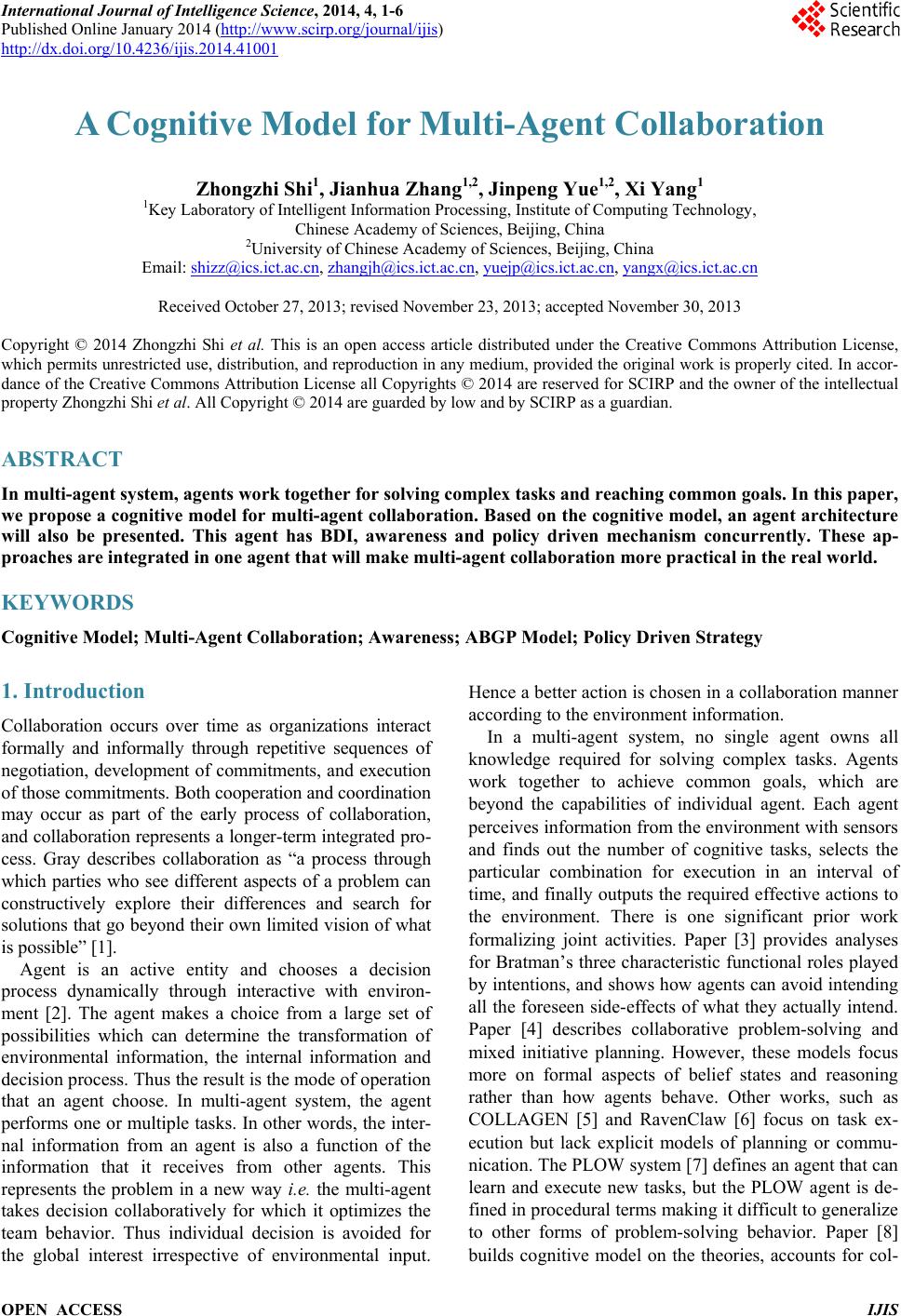 International Journal of Intelligence Science, 2014, 4, 1-6 Published Online January 2014 (http://www.scirp.org/journal/ijis) http://dx.doi.org/10.4236/ijis.2014.41001 OPEN ACCESS IJIS A Cognitive Model for Multi-Agen t C ollabor ation Zhongzhi Shi1, Jianhua Zhang1,2, Jinpeng Yue1,2, Xi Yang1 1Key Laboratory of Intelligent Information Processing, Institute of Computing Technology, Chinese Academy of Sciences, Beijing, China 2University of Chinese Academy of Sciences, Beijing, China Email: shizz@ics.ict.ac.cn, zhangjh@ics.ict.ac.cn, yuejp@ics.ict.ac.cn, yangx@ics.ict.ac.cn Received October 27, 2013; revised November 23, 2013; accepted November 30, 2013 Copyright © 2014 Zhongzhi Shi et al. This is an open access article distributed under the Creative Commons Attribution License, which permits unrestricted use, distribution, and reproduction in any medium, provided the original work is properly cited. In accor- dance of the Creative Commons Attribution License all Copyrights © 2014 are reserved for SCIRP and the owner of the intellectual property Zhongzhi Shi et al. All Copyright © 2014 are guarded by low and by SCIRP as a guardian. ABSTRACT In multi-agent system, agents work together for solving compl ex tasks and reach i ng comm on g oals. In thi s paper, we propose a cognitive model fo r multi-agent collaboration. Based on the cognitive model, an agent architecture will also be presented. This agent has BDI, awareness and policy driven mechanism concurrently. These ap- proaches are integrated in one agent that will make multi-agent collaboration more practical in the real world. KEYWORDS Cognitive Model; Multi -Agent Collaboration ; Aw are ness; ABGP Model; Policy Driven S trategy 1. Introduction Collaboration occurs over time as organizations interact formally and informally through repetitive sequences of negotiation, development of commitments, and execution of those commitments. Both cooperation and coordination may occur as part of the early process of collaboration, and collaboration represents a longer-term integrated pro- cess. Gray describes collaboration as “a process through which parties who see different aspects of a problem can constructively explore their differences and search for solutions that go beyond their own limited vision of what is possible” [1]. Agent is an active entity and chooses a decision process dynamically through interactive with environ- ment [2]. The agent makes a choice from a large set of possibilities which can determine the transformation of environmental information, the internal information and decision process. Thus the result is the mode of operation that an agent choose. In multi-agent system, the agent performs one or multiple tasks. In other words, the inter- nal information from an agent is also a function of the information that it receives from other agents. This represents the problem in a new way i.e. the multi-agent takes decision collaboratively for which it optimizes the team behavior. Thus individual decision is avoided for the global interest irrespective of environmental input. Hence a better action is chosen in a collaboration manner according to the environment information. In a multi-agent system, no single agent owns all knowledge required for solving complex tasks. Agents work together to achieve common goals, which are beyond the capabilities of individual agent. Each agent perceives information from the environment with sensors and finds out the number of cognitive tasks, selects the particular combination for execution in an interval of time, and finally outputs the required effective actions to the environment. There is one significant prior work formalizing joint activities. Paper [3] provides analyses for Bratman’s three characteristic functional roles pla yed by intentions, and shows how agents can avoid intending all the foreseen side-effects of what they actually intend. Paper [4] describes collaborative problem-solving and mixed initiative planning. However, these models focus more on formal aspects of belief states and reasoning rather than how agents behave. Other works, such as COLLAGEN [5] and RavenClaw [6] focus on task ex- ecution but lack explicit models of planning or commu- nication. The PLOW system [7] defines an agent that can learn and execute new tasks, but the PLOW agent is de- fined in procedural terms making it difficult to generalize to other forms of problem-solving behavior. Paper [8] builds cognitive model on the theories, accounts for col- 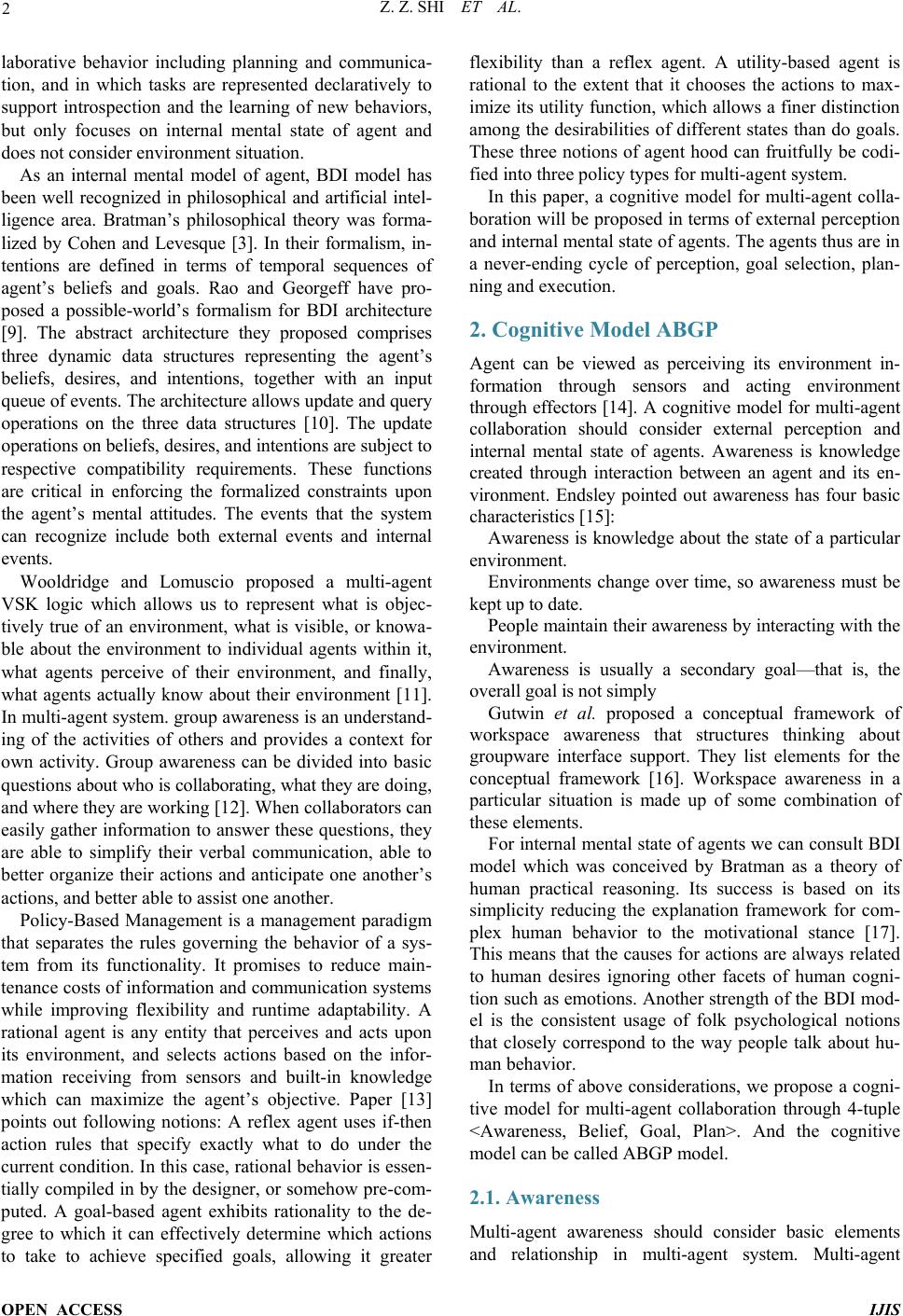 Z. Z. SHI ET AL. OPEN ACCESS IJIS laborative behavior including planning and communica- tion, and in which tasks are represented declaratively to support introspection and the learning of new behaviors, but only focuses on internal mental state of agent and does not consider environment situation. As an internal mental model of agent, BDI model has been well recognized in philosophical and artificial intel- ligence area. Bratman’s philosophical theory was forma- lized by Cohen and Levesque [3]. In their formalism, in- tentions are defined in terms of temporal sequences of agent’s beliefs and goals. Rao and Georgeff have pro- posed a possible-world’s formalism for BDI architecture [9]. The abstract architecture they proposed comprises three dynamic data structures representing the agent’s beliefs, desires, and intentions, together with an input queue of events. The architecture allows update and query operations on the three data structures [10]. The update operations on beliefs, desires, and intentions are subject to respective compatibility requirements. These functions are critical in enforcing the formalized constraints upon the agent’s mental attitudes. The events that the system can recognize include both external events and internal events. Wooldridge and Lomuscio proposed a multi-agent VSK logic which allows us to represent what is objec- tively true of an environment, what is visible, or knowa- ble about the environment to individual agents within it, what agents perceive of their environment, and finally, what agents actually know about their environment [11]. In multi-agent syste m. group awareness is an understand- ing of the activities of others and provides a context for own activity. Group awareness can be divided into basic questions about who is collaborating, what they are doing, and where they are working [12]. When collaborators can easily gather information to answer these questions, they are able to simplify their verbal communication, able to better organize their actions and anticipate one another’s actions, and better able to assist one another. Policy-Based Management is a management paradigm that separates the rules governing the behavior of a sys- tem from its functionality. It promises to reduce main- tenance costs of information and communication systems while improving flexibility and runtime adaptability. A rational agent is any entity that perceives and acts upon its environment, and selects actions based on the infor- mation receiving from sensors and built-in knowledge which can maximize the agent’s objective. Paper [13] points out following notions: A reflex agent uses if-then action rules that specify exactly what to do under the current condition. In this case, rational behavior is essen- tially compiled in by the designer, or somehow pre-com- puted. A goal-based agent exhibits rationality to the de- gree to which it can effectively determine which actions to take to achieve specified goals, allowing it greater flexibility than a reflex agent. A utility-based agent is rational to the extent that it chooses the actions to max- imize its utility function, which allows a finer distinction among the desirabilities of different states than do goals. These three notions of agent hood can fruitfully be codi- fied into three policy types for multi-agent system. In this paper, a cognitive model for multi-agent colla- boration will be pr oposed in terms of external perception and internal mental state of agents. The agents thus are in a never-ending cycle of perception, goal selection, plan- ning and execution. 2. Cognitive Model ABGP Agent can be viewed as perceiving its environment in- formation through sensors and acting environment through effectors [14]. A cognitive model for multi-agent collaboration should consider external perception and internal mental state of agents. Awareness is knowledge created through interaction between an agent and its en- vironment. Endsley pointed out awareness has four basic characteristics [15]: Awareness is knowledge about the state of a particular environment. Environments change over time, so awareness must be kept up to da t e . People maintain their awareness by in teracting with the environment. Awareness is usually a secondary goal—that is, the overall goa l i s not simply Gutwin et al. proposed a conceptual framework of workspace awareness that structures thinking about groupware interface support. They list elements for the conceptual framework [16]. Workspace awareness in a particular situation is made up of some combination of these elements. For internal mental state of agents we can consult BDI model which was conceived by Bratman as a theory of human practical reasoning. Its success is based on its simplicity reducing the explanation framework for com- plex human behavior to the motivational stance [17]. This means that the causes for actions are always related to human desires ignoring other facets of human cogni- tion such as emotions. Another strength of the BDI mod- el is the consistent usage of folk psychological notions that closely correspond to the way people talk about hu- man behavior. In terms of above considerations, we propose a cogni- tive model for multi-agent collaboration through 4-tuple <Awareness, Belief, Goal, Plan>. And the cognitive model can be called ABGP model. 2.1. Awareness Multi-agent awareness should consider basic elements and relationship in multi-agent system. Multi-agent  Z. Z. SHI ET AL. OPEN ACCESS IJIS awareness model is defined as 2-tuple MA = {Element, Relation}, where Elem ents of awareness as follows: Identity (Role): Who is participating? Location: Where are they? Intent i ons : What a re they going t o do? Actions: What a re they doing? Abilities: What can they do? Objects: What objects are they using? Tim e point: When do the action execute? Basic relationships contain task relationship, role rela- tionship, operation relationship, activity relationship and cooperat i on r e l a tionships. Task relationships define task decomposition and composition relationships. Task involves activities with a clear and unique role attribute Role relationships describe the role relationship of agents in the multi-agent activities. Operation relationships describe the operation set of agents. Activity relationships describe activity of the role at a time. Cooperation relationships describe the interactions be- tween agents. A partnership can be investigated through cooperation activities relevance among agents to ensure the transmissio n of information between different p ercep- tion of the role and tasks for maintenance of the entire mul ti -agent perception 2.2. Belief Belief represents the information, an agent has the world it inhabits and its own internal state. This introduces a personal world v iew inside the agent. Belief can often be seen as knowledge base of an agent, which contains ab- undant contents, including basic axioms, objective facts, data and so on. Belief knowledge base is a 3-triple K = <T, S, B>, where, T describes the basic concepts in the field and their definitions, axioms form domain concepts, namely domain ontology; S is the domain between facts and formulas there is a causal relationship between con- straints, called causality constraint axiom, which ensures consistency and integr ity of the knowledge base; B is the set of beliefs in current state, containing facts and data. The contents of B is changed dynamically. 2.3. Goal Goals represent the agent’s wishes and drive the course of its actions. A goal deliberation process has the task to select a subset of consistent desires. In a goal-oriented design, different goal types such as achieve or maintain goals can be used to explicitly represent the states to be achieved or maintained, and therefore the reasons, why actions are executed. Moreover, the goal concept allows modeling agents which are not purely reactive i.e., only acting after the occurrence of some event. Agents that pursue the i r o wn goals exhibit pro-act i ve behavior. There are three ways to generate goals: System designer sets the goal or the goal will be se- lected when the system initializing. Generate the goal according to observing the dynamic of the environm e nt . Goals generate mainly stem from internal state of agent. 2.4. Plan When a certain goal is selected, agent must looking for an effective way to achieve the goal, and sometimes even need to modify the existing goal, this reasoning process is called planning. In order to accomplish this plan reason- ing, agent can adopt two ways: one is using already pre- pared plan library, which includes some of the planning for the actual inference rules which also called static planning; another way is instantly planning, namely dy- namic pr ogra mming. Static plan is aimed at some specific goal, pre- estab- lished goals needed to achieve these basic processes and methods, thus forming the corresponding goals and plan- ning some of the rules, that planning regulations. Since these rules in the system design has been written, the planning process actually becomes a search in the library in the pla nning proc e s s of matchi ng. Dynamic plan finds an effective way to achieve the goals and means for a certain goal which based on the beliefs of current status, combined with the main areas of the axioms and their action description. In the dynamic situation, the environment domain is dynamically chang- ing, the beliefs are also constantly changing. Even for the same goal, in a different state, the planning and imple- mentation of processes may be different. Therefore, the dynamic plan is very important for multi-agent system, especially i n a complex environme nt. In dynamic mode, we use top-down methods. Typically a goal might be composed by a number of sub-goals, so we must fi rst achieve all sub-goals of the goal. 3. Policy-Driven Strategy There are many definitions about the policy, and differ- nent area has different standard. For example, IETF/ DMTF policy is defined as a series of management to a set of rules [18]. Many people regard the policy simply equated with defined rules, which is obviously too narrow. We use relatively bro ad, loosely definition: p olicy is used to guide the behavior of the system means. In the mul- ti-agent system, policy describes agent behavior that mu st be followed, which reflects the human judgment. Policy 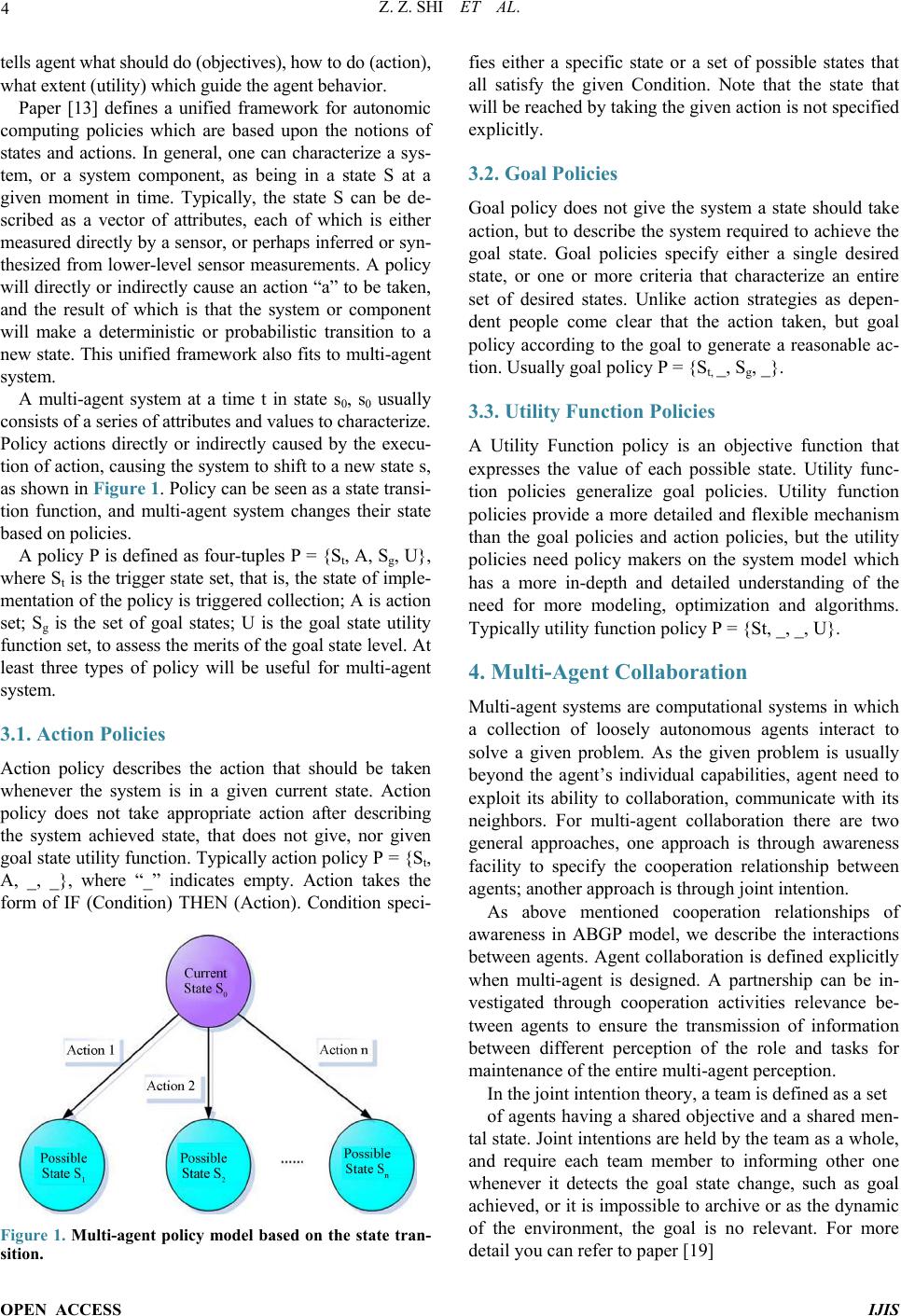 Z. Z. SHI ET AL. OPEN ACCESS IJIS tells agent what should do (ob je c tives), how to do (action), what exte nt (utilit y) which guide the age nt behavi or. Paper [13] defines a unified framework for autonomic computing policies which are based upon the notions of states and actions. In general, one can characterize a sys- tem, or a system component, as being in a state S at a given moment in time. Typically, the state S can be de- scribed as a vector of attributes, each of which is either measured directly by a sensor, or perhaps inferred or syn- thesized from lower-level sensor measurements. A policy will directly or indirectly cause an action “a” to be taken, and the result of which is that the system or component will make a deterministic or probabilistic transition to a new state. This unif ied framework also fits to multi-agent system. A multi-agent system at a time t in state s0, s0 usually consists of a series of attributes and values to characterize. Policy actions directly or indirectly caused by the execu- tion of action, cau sing the system to sh ift to a new state s, as shown in Figure 1 . Policy can be seen as a state transi- tion function, and multi-agent system changes their state based on poli ci es. A policy P is defined as four-tuples P = {St, A, Sg, U}, where St is the trigger state set, th at is, the state of impl e- mentation of the policy is triggered collection; A is action set; Sg is the set of goal states; U is the goal state utility function se t, to assess the merits of th e goal state level. At least three types of policy will be useful for multi-agent system. 3.1. Action Policies Action policy describes the action that should be taken whenever the system is in a given current state. Action policy does not take appropriate action after describing the system achieved state, that does not give, nor given goal state utility f unction . Typically action policy P = {St, A, _, _}, where “_” indicates empty. Action takes the form of IF (Condition) THEN (Action). Condition speci- Figure 1. Multi-agent policy model based on the state tran- sition. fies either a specific state or a set of possible states that all satisfy the given Condition. Note that the state that will be reached by taking the given action is not specified explicitly. 3.2. Goal Policies Goal policy does not give the system a state should take action, but to describe the system required to achieve the goal state. Goal policies specify either a single desired state, or one or more criteria that characterize an entire set of desired states. Unlike action strategies as depen- dent people come clear that the action taken, but goal policy according to the goal to generate a reasonable ac- tion. Usually goal policy P = {St, _, Sg, _}. 3.3. Utility Function Policies A Utility Function policy is an objective function that expresses the value of each possible state. Utility func- tion policies generalize goal policies. Utility function policies provide a more detailed and flexible mechanism than the goal policies and action policies, but the utility policies need policy makers on the system model which has a more in-depth and detailed understanding of the need for more modeling, optimization and algorithms. Typically utility function policy P = {St, _, _, U}. 4. Multi-Agent Collaboration Multi-agent systems are computational systems in which a collection of loosely autonomous agents interact to solve a given problem. As the given problem is usually beyond the agent’s individual capabilities, agent need to exploit its ability to collaboration, communicate with its neighbors. For multi-agent collaboration there are two general approaches, one approach is through awareness facility to specify the cooperation relationship between agents; another approach is through joint intention. As above mentioned cooperation relationships of awareness in ABGP model, we describe the interactions between agents. Agent collaboration is defined explicitly when multi-agent is designed. A partnership can be in- vestigated through cooperation activities relevance be- tween agents to ensure the transmission of information between different perception of the role and tasks for maintenance of the entire multi-agent perception. In the joint intention theory, a team is defined as a set of agents having a shared objective and a shared men- tal state. Joint inten tions are held by the team as a w hole, and require each team member to informing other one whenever it detects the goal state change, such as goal achieved, or it is impossible to archive or as the dynamic of the environment, the goal is no relevant. For more detail you can refer to paper [19] 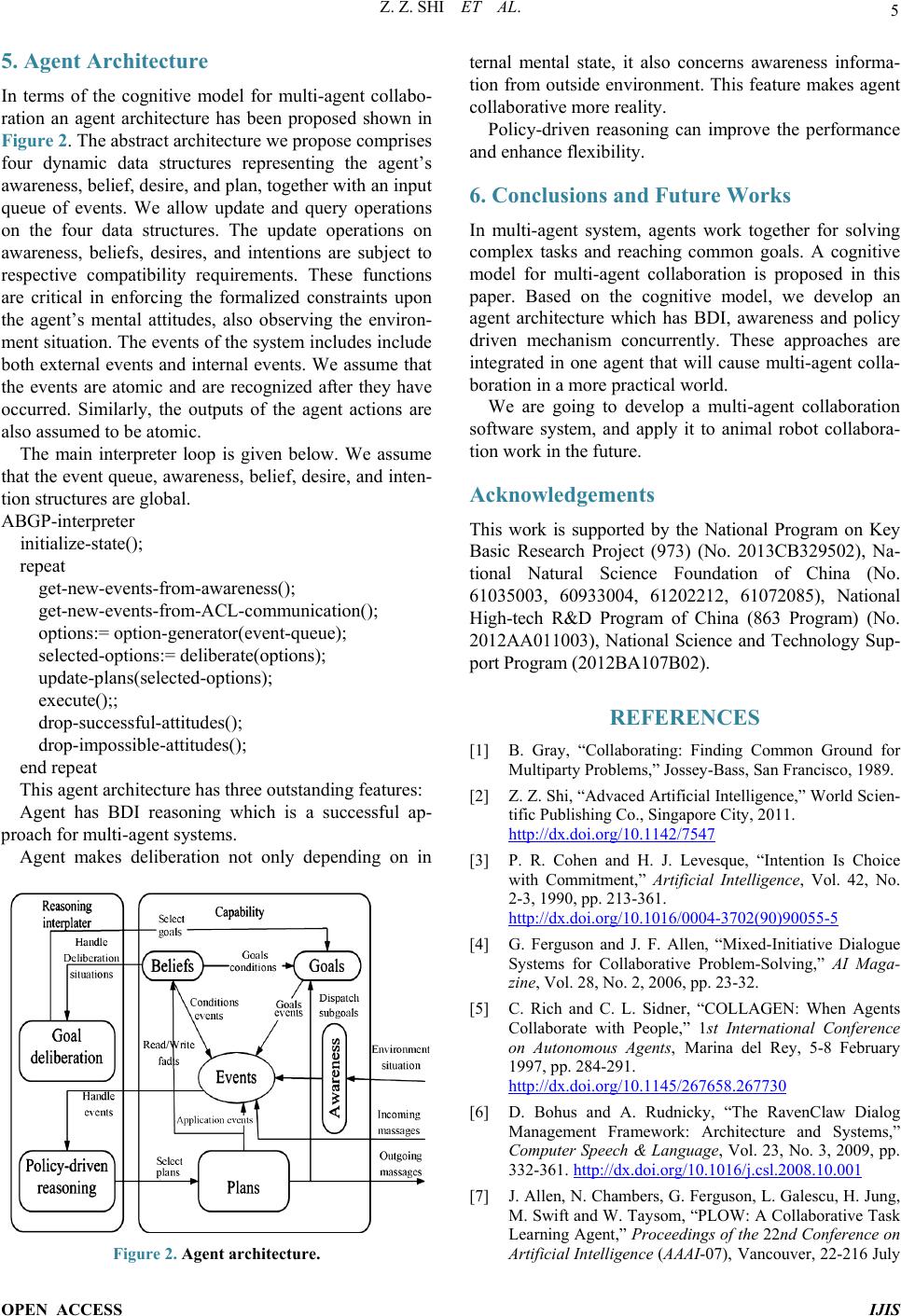 Z. Z. SHI ET AL. OPEN ACCESS IJIS 5. Agent Architecture In terms of the cognitive model for multi-agent collabo- ration an agent architecture has been proposed shown in Figure 2. The abstract architecture we propose comprises four dynamic data structures representing the agent’s awareness, belief, desire, and plan, together with an input queue of events. We allow update and query operations on the four data structures. The update operations on awareness, beliefs, desires, and intentions are subject to respective compatibility requirements. These functions are critical in enforcing the formalized constraints upon the agent’s mental attitudes, also observing the environ- ment situation. The events of the system includes include both external events and internal events. We assume that the events are atomic and are recognized after they have occurred. Similarly, the outputs of the agent actions are also assumed to be atomic. The main interpreter loop is given below. We assume that the event queue, awareness, belief, desire, and inten- tion structures are global. ABGP-interpreter initialize-state(); repeat get-new-events-from-awareness(); get-new-events-from-ACL-communication(); options := option-generator(event-queue); selected-options := de lib erate(options); update-plan s (selected-options); execute();; drop-successful-attitudes(); drop-impo ssible-attitudes(); e n d repeat This agent architecture has three outstanding features: Agent has BDI reasoning which is a successful ap- proach for multi-agent systems. Agent makes deliberation not only depending on in Figure 2. Agent architecture. ternal mental state, it also concerns awareness informa- tion from outside environment. This feature makes agent collaborative more reality. Policy-driven reasoning can improve the performance and enhance flexibility. 6. Conclusions and Future Works In multi-agent system, agents work together for solving complex tasks and reaching common goals. A cognitive model for multi-agent collaboration is proposed in this paper. Based on the cognitive model, we develop an agent architecture which has BDI, awareness and policy driven mechanism concurrently. These approaches are integrated in one agent that will cause multi-agent colla- boration in a more practical world. We are going to develop a multi-agent collaboration software system, and apply it to animal robot collabora- tion work in the future. Acknowledgements This work is supported by the National Program on Key Basic Research Project (973) (No. 2013CB329502), Na- tional Natural Science Foundation of China (No. 61035003, 60933004, 61202212, 61072085), National High-tech R&D Program of China (863 Program) (No. 2012AA011003), National Science and Technology Sup- port Program (2012BA107B02). REFERENCES [1] B. Gray, “Collaborating: Finding Common Ground for Multiparty Problems,” Jossey-Bass, San Francisco, 1989. [2] Z. Z. Shi, “Advaced Artificial Intelligence,” World Scien- tific Publishing Co., Singapore City, 2011. http://dx.doi.org/10.1142/7547 [3] P. R. Cohen and H. J. Levesque, “Intention Is Choice with Commitment,” Artificial Intelligence, Vol. 42, No. 2-3, 1990, pp. 213-361. http://dx.doi.org/10.1016/0004-3702(90)90055-5 [4] G. Ferguson and J. F. Allen, “Mixed-Initiative Dialogue Systems for Collaborative Problem-Solving,” AI Maga- zine, Vol. 28, No. 2, 2006, pp. 23-32. [5] C. Rich and C. L. Sidner, “COLLAGEN: When Agents Collaborate with People,” 1st International Conference on Autonomous Agents, Marina del Rey, 5-8 February 1997, pp. 284-291. http://dx.doi.org/10.1145/267658.267730 [6] D. Bohus and A. Rudnicky, “The RavenClaw Dialog Management Framework: Architecture and Systems,” Computer Speech & Language, Vol. 23, No. 3, 2009, pp. 332-361. http://dx.doi.org/10.1016/j.csl.2008.10.001 [7] J. Allen, N. Chambers, G. Ferguson, L. Galescu, H. Jung, M. Swift and W. Taysom, “PLOW: A Collaborative Task Learning Agent,” Proceedings of the 22nd Conference on Artificial Intelligence (AAAI-07), Vancouver, 22-216 July 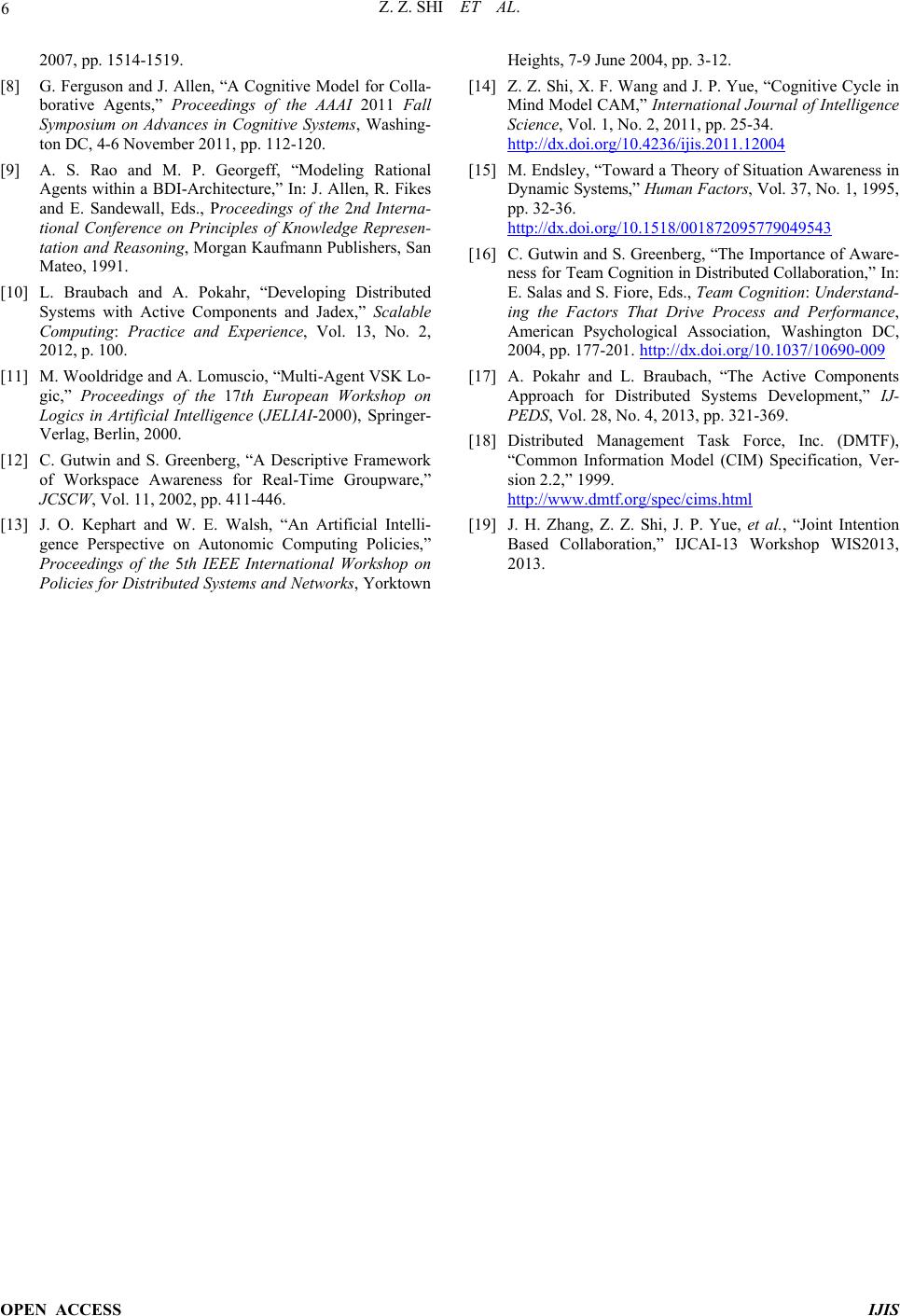 Z. Z. SHI ET AL. OPEN ACCESS IJIS 2007, pp. 1514-1519. [8] G. Ferguson and J. Allen, “A Cognitive Model for Colla- borative Agents,” Proceedings of the AAAI 2011 Fall Symposium on Advances in Cognitive Systems, Washing- ton DC, 4-6 November 2011, pp. 112-120. [9] A. S. Rao and M. P. Georgeff, “Modeling Rational Agents within a BDI-Architecture,” In: J. Allen, R. Fikes and E. Sandewall, Eds., Proceedings of the 2nd Interna- tional Conference on Principles of Knowledge Represen- tation and Reasoning, Morgan Kaufmann Publishers, San Mateo, 1991. [10] L. Braubach and A. Pokahr, “Developing Distributed Systems with Active Components and Jadex,” Scalable Computing: Practice and Experience, Vol. 13, No. 2, 2012, p. 100. [11] M. Wooldridge and A. Lomusc io , “Multi-Agent VSK Lo- gic,” Proceedings of the 17th European Workshop on Logics in Artificial Intelligence (JELIAI-2000), Springer- Verlag, Berlin, 2000. [12] C. Gutwin and S. Greenberg, “A Descriptive Framework of Workspace Awareness for Real-Time Groupware,” JCSCW, Vol. 11, 2002, pp. 411-446. [13] J. O. Kephart and W. E. Walsh, “An Artificial Intelli- gence Perspective on Autonomic Computing Policies,” Proceedings of the 5th IEEE International Workshop on Policies for Distributed Systems and Networks, Yorktown Heights, 7-9 June 2004, pp. 3-12. [14] Z. Z. Shi, X. F. Wang and J. P. Yue, “Cognitive Cycle in Mind Model CAM,” International Journal of Intelligence Science, Vol. 1, No. 2, 2011, pp. 25-34. http://dx.doi.org/10.4236/ijis.2011.12004 [15] M. Endsley, “Toward a Theory of Situation Awareness in Dynamic Syst ems,” H uman Factors, Vol. 37, No. 1, 1995, pp. 32-36. http://dx.doi.org/10.1518/001872095779049543 [16] C. Gutwin and S. Greenberg, “The Importance of Aware- ness for Team Cognition in Distribut ed Collaboration,” In: E. Salas and S. Fiore, E ds., Team Cognition: Understand- ing the Factors That Drive Process and Performance, American Psychological Association, Washington DC, 2004, pp. 177-201. http://dx.doi.org/10.1037/10690-009 [17] A. Pokahr and L. Braubach, “The Active Components Approach for Distributed Systems Development,” IJ- PEDS, Vol. 28, No. 4, 2013, pp. 321-369. [18] Distributed Management Task Force, Inc. (DMTF), “Common Information Model (CIM) Specification, Ver- sion 2.2,” 1999. http://www.dmtf.org/spec/cims.html [19] J. H. Zhang, Z. Z. Shi, J. P. Yue, et al., “Joint Intention Based Collaboration,” IJCAI-13 Workshop WIS2013, 2013.
|